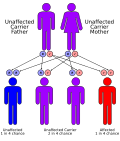Werner syndrome: Difference between revisions
CSV import |
|||
| Line 99: | Line 99: | ||
[[Category:Syndromes affecting bones]] | [[Category:Syndromes affecting bones]] | ||
[[Category:Syndromes affecting the nervous system]] | [[Category:Syndromes affecting the nervous system]] | ||
<gallery> | |||
File:autorecessive.svg|Werner syndrome | |||
</gallery> | |||
Latest revision as of 00:40, 20 February 2025
Werner syndrome (WS), also known as "adult progeria," is a rare autosomal recessive disorder characterized by the appearance of premature aging.
History[edit]
Werner syndrome is named after the German scientist Otto Werner, who identified the syndrome in four siblings displaying premature aging. He explored this condition as the subject of his dissertation in 1904.
Epidemiology[edit]
The global incidence rate of Werner syndrome is less than 1 in 100,000 live births, although it is more prevalent in certain populations such as Japan and Sardinia, affecting approximately 1 in 20,000–40,000 and 1 in 50,000 individuals, respectively. As of 2006, around 1,300 cases had been reported.
Presentation[edit]
Patients with Werner syndrome exhibit various signs and symptoms, including growth retardation, short stature, premature graying of hair, alopecia, wrinkling, prematurely aged faces with beaked noses, skin atrophy with scleroderma-like lesions, lipodystrophy, abnormal fat deposition leading to thin legs and arms, and severe ulcerations around the Achilles tendon and malleoli.
Gene Expression[edit]
Gene transcription changes found in Werner syndrome cells closely resemble those observed in normal aging. The deficiency of WRN protein causes alterations in gene expression patterns similar to those seen in normal aging.
Diagnosis and Clinical Symptoms[edit]
Werner syndrome is caused by mutations in the WRN gene, inherited in an autosomal recessive pattern. Patients typically display rapid premature aging beginning in young adulthood, usually in their early twenties. Diagnosis is based on six cardinal symptoms: premature graying of hair or hair loss, bilateral cataracts, atrophied or tight skin, soft tissue calcification, sharp facial features, and an abnormal, high-pitched voice. Patients also tend to have decreased fertility.
Causes[edit]
Approximately 90% of individuals with Werner syndrome have mutations in the WRN gene, which is solely attributed to causing the disorder. The WRN protein plays crucial roles in various DNA repair processes, including non-homologous end joining, homologous recombination repair, and DNA cross-link repair.
Werner syndrome (WS), also known as "adult progeria," is a rare autosomal recessive disorder characterized by the appearance of premature aging.
Effects on Cell Structure and Function[edit]
Mutations in the WRN gene result in various effects, such as decreased stability of transcribed messenger RNA, truncation of the WRN protein, and aberrant association with p53, leading to reduced DNA repair and cell instability. Loss of WRN helicase activity contributes to telomere dysfunction and cell instability, potentially leading to premature aging symptoms and increased susceptibility to cancer.
Treatment[edit]
Currently, no cure for Werner syndrome exists. Treatment mainly focuses on managing associated diseases and alleviating symptoms to improve quality of life. Skin ulcers can be treated with topical treatments or surgery in severe cases. Associated diseases like diabetes and cancer are managed similarly to non-Werner syndrome individuals, with diet, exercise, and regular screenings playing important roles in disease management and prevention.
References[edit]
Werner Syndrome and Cancer: Lessons Learned Werner Syndrome: From Molecular Pathogenesis Towards the Understanding of Accelerated Aging Werner Syndrome Protein: Functions in the Response to DNA Damage and Age-Related Changes in Gene Expression
See also[edit]
- Werner Syndrome from GeneReviews™, contains extensive information on the disorder
| Metabolic disease: DNA replication and DNA repair-deficiency disorder | ||||
|---|---|---|---|---|
|
| Progeroid syndromes | ||||||
|---|---|---|---|---|---|---|
|




